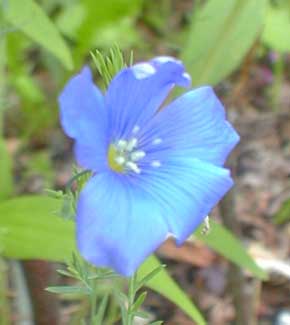
'Sapphire Blue'
Perennial Flax
"Blue were her eyes as the fairy-flax."
-Henry Wadsworth Longfellow
(1807-1882)
(1807-1882)
The perennial flax Linum perenne (aka L. lewisii) 'Sapphire' or 'Sapphire Blue' blooms May through August or longer. If it stops blooming in summer it should be sheered back by half to start again.
It stands one to two feet tall, the full length of its upright stems having feathery bluish green foliage, topped by the blue flowers.
It likes rock gardens, well-draining mixed perennial borders, raised gardens, or mixed containers. Its natural habitat is meadows & grasslands or prairies of western North America where it is apt to experience wet springs & dry the rest of the year. It now grows in many places around the globe, being rather easily naturalized wherever it meets ideal conditions.
In autumn & winter when it has died back it needs exceptionally well draining soil or may rot out of the garden during a rainy winter; it's otherwise exceedingly hardy for zone 7 or 8. It can grow in full sun or partial shade, though in the coastal Pacific Northwest it prefers a sunny spot.
It'll want regular watering during its long bloom season, but can dry out a bit between waterings. It's drought tolerant but will not look its best in an outright xeriscape garden. It's easily damaged by frost, so the length of its season varies, blooming longest where all seasons are mild.
It's shortlived as a perennial but easily self-seeds in any garden that's not too wet in winter.
Raw seeds contain cyanide & can be toxic if eaten uncooked. Native americans ate flax seeds after they were well cooked or roasted, when they acquire a pleasing taste similar to pistachio.
Flaxseed lignan is today used as an ingredient in some bakery goods & healthfood products. A randomized controlled study by Dahl et al (2005) established that flax fiber in baked goods provided healthful blood glucose (glycemic) responses above & beyond ordinary white bread.
Flax fibers obtained from the stems have been used for linen cloth, string, & paper manufacture. Extracted linseed oil has many practical uses including for cosmetics, artist paints, & varnishes.
Flax oil was traditionally used as a home remedy for all manner of ailments like stomach upset, constipation, or soar throat. The leaves were traditionally prepared for use in treating rheumatism or as topical poultice for bruising or strained muscles.
Most of its medicinal uses are not well attested in medical literature, but several remarkable values have been validated to one degree or another. Experiments on mice conducted by Kinnery et al (2006) suggest that dietary flaxseed relieves lung tissue swelling, lending credance to its traditional use for coughs & colds. A study of flaxseed supplementation conducted by Mandasescu et al (2005) indicated value for "modifying cardiovascular risk factors."
And a randomized controlled study by Dalais et al (2004), of men diagnosed with prostate cancer, discovered that bread rich in soy grits & flax fibre reduced development & progression of the cancer, due to the beneficial effects of phytoestrogens on the prostrate gland.
Good studies on flax seed oil have also found benefits for mind & brain. An animal-modeled study by Barcelo-Coblijin et al (2005) showed that docosahexaenoic acid levels were increased in the brains of rats fed dietary flaxseed oil. The effects were similar to the effect of fish oil supplements on brain function so should make a good "vegetarian" substitute for fish oil, providing proven benefit.
A research study of children with ADHD-related learning difficulties (Joshi et al, 2006) discovered that supplementation of flax oil & vitamin C provided significant levels of control of hyperactivity, as scored on an ADHD rating scale. This study provided evidence that imbalances in highly unsaturated fatty acids may be one underlying cause of attention deficiency & hyperactivity disorders, & this imbalance can be corrected by the fatty acids in flax oil. The implication is that flax may be a valid herbal treatment for children who might otherwise be put on doses of ridelin & similarly spooky drugs.